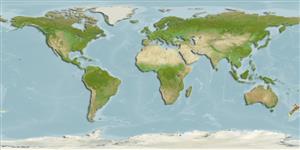>
Aulopiformes (Grinners) >
Aulopidae (Aulopus)
Etymology: Leptaulopus: Name from Greek 'leptos' meaning slender and 'aulopus' for a name long applied to the broader group of fi�shes to which the genusbelong; referring to the slender form of the speciesit comprises.; erythrozonatus: Name from Greek 'erythros' for ‘red’ and 'zone' for ‘belt’, referring to the distinctive red bands on the dorsal and caudal fins..
Environment: milieu / climate zone / depth range / distribution range
Ecologia
marinhas demersal; intervalo de profundidade 130 - 280 m (Ref. 94775). Subtropical
Southwestern Pacific: apparently confined to the Australasian region with a trans-Tasman distribution; recorded from New Zealand (Bay of Plenty), northern New South Wales (NE coast of North I. and off Batemans Bay), and yet to be confirmed from Norfolk Ridge.
Tamanho / Peso / Idade
Maturity: Lm ? range ? - ? cm
Max length : 27.4 cm SL macho/indeterminado; (Ref. 94775)
Descrição breve
Morfologia | Morfometria
Raios dorsais moles (total): 15-16; Raios anais moles: 10 - 11; Vértebras: 44. This species is distinguished by the following characters: D 15-16; A 10-11; vertebrae 26 or 27 + 17 or 18 = 44; lateral line scales 44 + 1, below lateral line 4.5; predorsal scales 20; gill rakers 3 + 12; elongated snout, length 11.5-12.4% SL and 34.6-36.5% HL, which is much longer than eye diameter, dorsoventrally flattened, narrowly rounded from above; narrow bony interorbital, width 3.0-3.5% SL and 8.9-10.3% HL; snout tip to dorsal fin origin 42.5-43.7% SL in distance and 128-129% HL; anal �n base 92-9.8% SL and 27.0-29.1% HL; colour of posterior end of maxilla and posterior and ventral margins of preopercle stark white; translucent dorsal fin with 4-6 narrow submarginal stripes from base to outer edge of fin, stripes posteriorly angled obliquely, intervening spaces of fin rays white; caudal fin white with 4-5 red bands crossing each lobe and proximal bands continuous
across fin in some (Ref. 94775).
Life cycle and mating behavior
Maturidade | Reprodução | Desova | Ovos | Fecundidade | Larvas
Gomon, M.F., C.D. Struthers and A.L. Stewart, 2013. A new genus and two new species of the family Aulopidae (Aulopiformes), commonly referred to as Aulopus Flagfins, Sergeant Bakers or Threadsails, in Australasian waters. Spec. Div. 18:141-161. (Ref. 94775)
Categoria na Lista Vermelha da IUCN (Ref. 130435)
Ameaça para o homem
Harmless
Utilização humana
Mais informação
Nomes comunsSinónimosMetabolismoPredadoresEcotoxicologiaReproduçãoMaturidadeDesovaAgregação para desovaFecundidadeOvosDesenvolvimento dos ovos
Idade/TamanhoCrescimentoComprimento-pesoComprimento-comprimentoFrequência de comprimentoMorfometriaMorfologiaLarvasDinâmica larvarRecrutamentoAbundânciaBRUVS
ReferênciasAquaculturaPerfil para aquaculturaEstirpesGenéticaElectrophoresesHereditariedadeDoençasProcessamentoNutrientsMass conversion
ColaboradoresFotografiasStamps, Coins Misc.SonsCiguateraVelocidadeTipo de nataçãoÁrea branquialOutras referênciasCérebrosVisão
Ferramentas
Relatórios especiais
Descarregue XML
Fontes da internet
Estimates based on models
Preferred temperature (Ref.
123201): 12.3 - 15.2, mean 13.9 °C (based on 12 cells).
Phylogenetic diversity index (Ref.
82804): PD
50 = 0.7500 [Uniqueness, from 0.5 = low to 2.0 = high].
Bayesian length-weight: a=0.00447 (0.00187 - 0.01067), b=3.12 (2.91 - 3.33), in cm total length, based on LWR estimates for this (Sub)family-body shape (Ref.
93245).
Nível Trófico (Ref.
69278): 4.0 ±0.7 se; based on size and trophs of closest relatives
Fishing Vulnerability (Ref.
59153): Low vulnerability (23 of 100).
